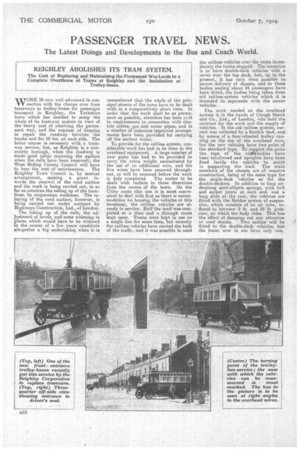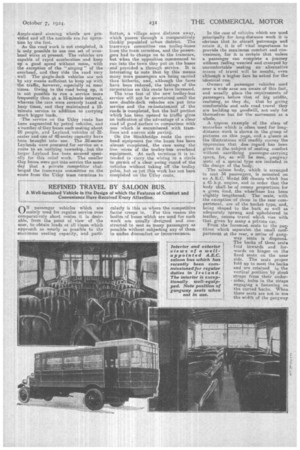PASSENGER TRAVEL NEWS.
Page 20

Page 21

If you've noticed an error in this article please click here to report it so we can fix it.
The Latest Doings and Developments in the Bus and Coach World.
KEIGHLEY ABOLISHES ITS TRAM SYSTEM.
The Cost of Replacing and Maintaining the Permanent Way Leads to a Complete Overthrow of Trams at Keighley and the Installation of Trolley-buses.
WORK IS now well advanced in connection with the change over from tramways to trolley-buses for passenger 'transport in Keighley, the Yorkshire town which has decided to scrap the whole of its tram way system in view of the heavy cost of renewing the permanent way, and the expense of keeping in repair the roadway between the tracks and for 18 ins. on each side. The latter course is necessary with a tramway service, but, as Keighley is a noncounty borough, when the roadway is made good (after renewing the surface when the rails have been removed), -the West Riding County Council will have to bear the cost of maintenance. The Keighley Town Council is, by mutual arrangement, making a grant towards the renewal of the road surface and the work is being carried out, in so far as concerns the taking up of the tramlines, by corporation workmen, The relaying of the road surface, however, is being carried out under contract by Highways Conetruction, Ltd., of London. , The taking up of the rails, the adjustment of levels, and some widening in places which would have to be widened in the course of a few years constitute altogether a big undertaking when it is
remembered that the whole of the principal streets of the town have to be dealt with in a comparatively short time. In order that the work shall be as permanent as possible, attention has been reit' to requirements in connection with electric cables, gas and water pipes, and in a number of instances improved arrangements have been provided for carrying off the surface water. •
To provide for the railless system, considerable work has had to be done to the overhead equipment. A large number of new poles has had to be provided to carry the extra weight necessitated by the use of an additional wire, and the live wires have been renewed throughout, or will be renewed before the work is duly completed. The routes to be dealt with radiate in three directions from the centre of the town. On the Utley route (the one it is most convenient to deal with first as there is accommodation for housing the vehicles at this terminus), the railless vehicles are already in service. Half the road was corn. plated at a time and a through route kept open. Trams were kept in use on a single line for some time, but recently the railless vehicles have carried the bulk of the traffic, and it was possible to send the railless vehicles over the route immediately the trams stopped. The intention is to have double-deck vehicles with a cover over the top deck, but, up to the present, it has only been possible to secure delivery of chassis, and to these bodies seating about 24 passengers have been fitted, the bodies being taken from old railless-system vehicles which it is intended to supersede with the newer vehicles.
The work needed on the overhead system is in the hands of Clough Smith and Co., Ltd., of London, who hold the contract I or the work and the supply of vehicles. In the old railless system, current was collected by a flexible lead, and by means of a four-wheeled trolley run. fling on the top of the overhead wire, but the new vehicles have two poles of the standard type. To support the poles the tops of the of^ bodies have been reinforced and nprights have been fixed inside the vehicles to assist in supporting the load. The main members of the chassis are of massive construction, being of the same type for the single-deck vehicles as for the double-deckers. In addition to long un.derislung semi-elliptic springs, with ball and socket joints at each end, and a long slide at the rear, the vehicles are fitted with the Holden system of suspension, which consists of an air tube, inflated to between 5 lb. and 10 lb. pressure, on which the body rides, This has the effect of damping out any vibration
or road shocks. Two motors will be fitted to the double-deck vehicles, batthe buses now in use have only one. Ample-sized steering wheels are provided and all the controls are for operation by the feet. As the road work is not completed, it is only possible to use one set of overhead wires at present. The vehicles are capable of rapid acceleration and keep up a good speed without noise, with the exception of the "singing" of the overhead, and they ride the road very well. The single-deck vehicles are not by any means sufficient to keep up with 'the traffic, however, especially at meal times. Owing to the road being up, it is not possible to run a service more frequently than at a 15-minute interval, olereas the cars were severely taxed at _busy times, and they maintained a 15minute service in addition to carrying much bigger loads.
The service on the Utley route has been augmented by petrol vehicles, and a number of Guy buses each seating about 20 people, and Leyland vehicles of 32seater and one of 4d-seater capacity have been brought into use. The 32-seater Leylands were promarecl.for service on a route to an outlying township, but the larger Leyland has • been secured specially for this relief work. The smaller Guy buses were put into service the .same day that a private competitor challenged the tramways committee on the route from the Utley tram terminus to
Sutton, a village some distance away, which passes through a comparatively thickly populated urban district. The tramways committee ran trolley-buses from the traria terminus, and the passengers had to change on to the tramcars, but when the opposition commenced to run into the town they put on the buses 'and provided a through service. It is interesting to note that by this means many more passengers are being carried than hitherto, and, although the farea have been reduced, the takings of the corporation on this route have increased.
The true test of the new trolley-bus service will not be ascertained until the new double-deck vehicles are put into service and the re-instatement of the roads is completed, but the half portion which has been opened to traffic gives an indication of the advantage of a dear road of good surface in comparison with one which is encumbered with tramlines and uneven side paving.
On the Stockbridge route the overhead equipment fur the buses has been elmost completed, the cars using the live wires of the trolley-bus overhead equipment. At each terminus it is intended to carry the wiring in a circle to permit of a clear swing round of the vehicles without taking off the trolley poles,, but as yet this work has not been completed on the Utley route.






























